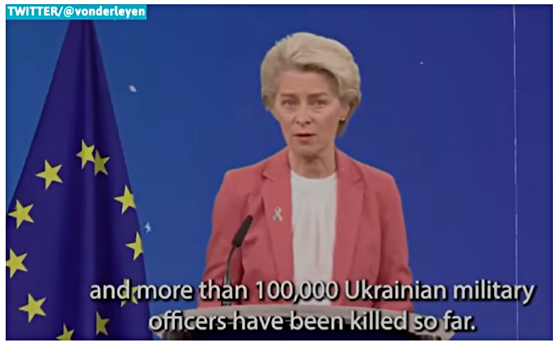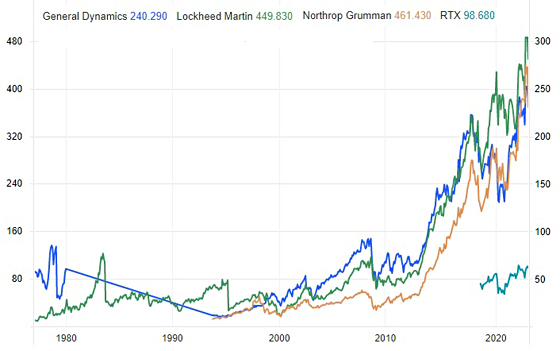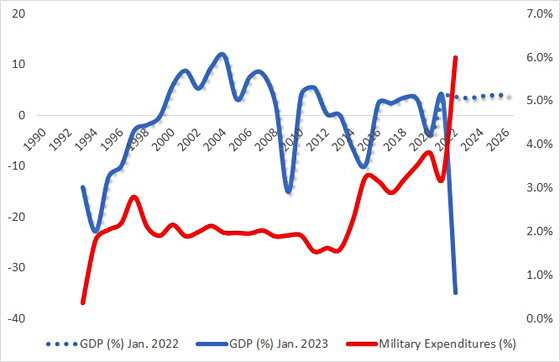Not only do these global military contractors arm Ukraine, but they stand to benefit from the re-militarization of Western Europe, Japan, and the new NATO members.
To Russia and Ukraine, the crisis is an existential issue. To the US and NATO, it’s a regime-change game. To Europe, it means the demise of stability – in the world economy, lost years (and that’s the benign scenario).
That’s how I characterized the US/NATO-led proxy war against Russia in Ukraine back in early March 2022. I argued that it was an "avoidable war that will penalize severely Ukraine, Russia, the US and the NATO, Europe, developing countries and the global economy."
At the time, the prediction was seen as contrarian. But it has prevailed. However, on January 25 the Ukraine proxy war entered a new, still more dangerous phase. The commitment of some 70 US, German, UK and Polish battle tanks herald lethal escalation, although hundreds more are needed to defeat Russia.
Not only will economic and human costs climb even further, but strategic risks, including the potential of nuclear confrontation, will soar. With such escalation in high-tech arms sales to Ukraine, regional and military spillovers are a matter of time.
Contradictory realities
Right before Christmas, President Volodymyr Zelensky delivered an emotional wartime appeal to a joint meeting of US Congress pleading for more military assistance from the lawmakers, who were about to approve $45 billion in additional aid. It was necessary for "eventual victory."
Yet, there was a huge disconnect between the triumphant declaration and the realities. Earlier in the month, European Commission President Ursula von der Leyen had acknowledged Ukraine’s losses in the war amounted to 100,000 soldiers and 20,000 civilians, though her tweet was quickly deleted and a new one was released without the true death count.
Figure 1: Contradictory Realities

Source: der Leyen’s tweet (source: screenshot)
Behind the choreographed photo-ops and bold soundbites, devastation had been expansive, progressive and relentless. In September 2022, a month before the Russian winter offensive, a World Bank report estimated that Russia’s invasion had caused over $97 billion in direct damages to Ukraine and it could cost $350 billion to rebuild the country. Worse, Ukraine had also suffered $252 billion in losses through disruptions to its economic flows and production, as well as extra expenses linked to the war. (The report was quiet about the economic and human costs on the Russian side.)
In other words, what Zelensky asked in the Congress was less than one-tenth of what is actually needed to rebuild Ukraine.
Ukrainian nightmare
In effect, even as international media was touting the mirage of Ukraine’s military triumph, the country’s real GDP declined over 35 percent on an annual basis in the third quarter of 2022; that is, before Russia’s massive infrastructure attack.
Starting on October 10, Russia’s waves of missile and drone attacks opened a new phase of the war. The direct physical damage to infrastructure soared to $127 billion already in September; that’s over 60 percent of Ukraine’s pre-war GDP. The impact on the productive capacity of key sectors, due to damage or occupation, is substantial and long-lasting.
The population share with income below the national poverty line in Ukraine may more than triple reaching nearly 60 percent in 2022. Poverty will increase from 5.5 percent in 2021 to 25 percent in 2022, with major downside risks if the war and energy security situations worsen. As casualties continue to mount, over a third of the population has been displaced and over half of all Ukrainian children have been forced to leave their homes. The nine months of war have caused massive population displacement. As of October 2022, the number of Ukrainian refugees recorded in Europe was over 7.8 million, and the number of internally displaced people was 6.5 million.
Figure 2 Overview of Population Displacement (Dec. 12, 2022)

Source: Ukraine Situation Report, UN-OCHA, Dec. 22, 2022
As former Pentagon adviser Col. (ret.) Douglas Macgregor has argued, “Washington’s refusal to acknowledge Russia’s legitimate security interests in Ukraine and negotiate an end to this war is the path to protracted conflict and human suffering.”
U.S. and international war funding
In the proxy war, economic and humanitarian aid to Ukraine has been abundant. By late fall, Congress had passed three aid packages totaling $68 billion. In turn, the Biden administration submitted a new aid request of $38 billion, which would bring the total to $106 billion. Though designed until September 2023, it is likely to be exhausted by May, assuming the current rate of spending ($6.8 billion per month). By then, the Biden White House must ask for additional funds.
Internationally, the US provides the bulk of total aid to Ukraine (62%). Aid from non-U.S. sources amounts to $41.4 billion. The international total of more than $110 billion accounts for more than half of Ukraine’s pre-war GDP ($200 billion).
Effectively, these funding arrangements aim to sustain the hostilities and destruction not just in 2023, but at least until the late 2020’s. A scenario the West’s recent arms sales escalation seems to reinforce.
Ukraine is "absolutely a weapons lab in every sense because none of this equipment has ever actually been used in a war between two industrially developed nations," said one source familiar with Western intelligence to CNN. "This is real-world battle testing."
Or as Zelensky put it more recently, arming Ukraine a “‘big business opportunity,” as evidenced by his government’s new ties with Blackrock, Goldman Sachs and JP Morgan. In December 2022, he revealed that Ukraine had hired Blackrock to "advice" Kyiv on how to use the West’s reconstruction funds, which he then estimated would have to increase at least to $1 trillion.
The Post-9/11 Wars: The Big Defense bonanza
As I predicted in March 2022, US Big Defense will be the only winner of the proxy war in Ukraine. Not only do these global military contractors arm Ukraine, but they stand to benefit from the re-militarization of Western European countries, Japan, and new NATO members. Washington has a great economic interest in such geopolitics. Brussels’s incentives are harder to fathom, especially as the euro area will also pay a hefty premium on energy and food, which will also benefit Washington.
For decades, security cooperation programs have led U.S. forces into unauthorized hostilities alongside foreign partners, particularly Afghanistan, Iraq, maybe Libya in in the past two decades. But the list is off by at least 17 countries in which the US has engaged in armed conflict through ground forces, proxy forces, or air strikes.
The simple reason is money. War may be a racket, but it is a very lucrative racket. In the past two decades alone, the cost of US global war on terror stands at $8 trillion and 900,000 deaths (the costs in target countries are far, far higher). And this estimate is from fall 2021, more than a year before the Ukraine bonanza.
War profiteering has always been lucrative to military contractors. But the post-9/11 wars represent an entirely different magnitude. During the past two decades, the stock prices of the Big Defense have doubled, quadrupled, even soared sixfold.
Figure 3 Post-9/11 Wars: The Big Defense Bonanza

Source: Tradingeconomics; DifferenceGroup, Jan 16, 2023
In 2014, Ukrainian military spending was about 3 percent of GDP, increasing to 6 percent in 2022, corresponding to more than $11 billion. In brief, Ukrainian military expenditures have doubled since the 2014 regime ploy. Meanwhile, its economic growth has tanked. Instead of the expected 3.7 percent in 2022, it plunged dramatically some 35 percent.
Figure 4 Ukraine’s economic growth and military expenditures, 1990-2026

Source: Data from SIPRI, IMF; Difference Group, Mar. 5, 2022, Jan. 2023
What’s ahead in 2023 will be worse. Reconstruction will require a lot more than $1 trillion. Ukraine as it is known has ceased to exist. The costs will mortgage Ukrainians to the third generation.
Undermined peace
As historian Geoffrey Roberts has argued, President "Putin went to war to prevent Ukraine from becoming an ever-stronger and threatening NATO bridgehead on Russia’s borders.” The war was not the Ukrainians’ first choice either. When Zelensky, whom Ukrainians elected as a "peace candidate," flirted with the idea of reconciliation with Russia in 2019, Ukraine’s notorious far-right supported by the West, torpedoed it.
Even in April 2022, after a month of hostilities, Russia and Ukraine tentatively agreed to end the war. But that decision was undermined by former British Prime Minister Boris Johnson. His Ukraine visit was designed to stop the talks, which were not acceptable to the US and some of its allies. Today, in Pentagon, Defense Secretary Lloyd Austin sees the escalation as "a window of opportunity here, between now and the spring."
Only a year ago, Ukraine, under Zelensky’s leadership, was still positioned to embrace neutrality, opt out from military alignments and serve as a bridge between Eastern and Western Europe, due to its position in China’s Bridge and Belt Initiative. Had that future prevailed, Ukraine might today be peaceful. Its GDP would be a third bigger. Young men would alive and well and have good jobs. Ukrainian refugees would be returning for new opportunities at home. Children wouldn’t suffer from traumatic nightmares.
Today, all those dreams are in ashes. The proxy war is aimed against Russia. The Ukrainians’ role is to die in it. The puppet masters are the primary beneficiaries.
Dr. Dan Steinbock is an internationally recognised strategist of the multipolar world and the founder of the Difference Group. He has served at the India, China and America Institute (US), Shanghai Institutes for International Studies (China) and the EU Centre (Singapore). For more, see https://www.differencegroup.net/
The original, fully-referenced analysis was published by The World Financial Review on January 27, 2023: https://worldfinancialreview.com/the-unwarranted-ukraine-proxy-war-a-year-later/ .


